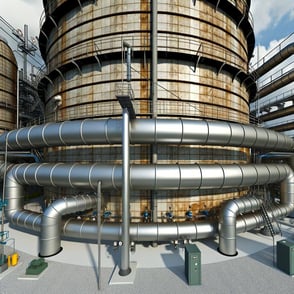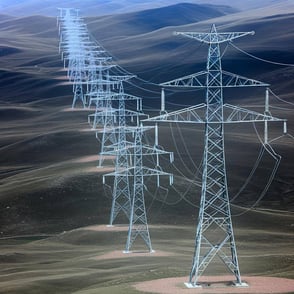Transformers
A transformer changes voltage levels to enable efficient electricity transmission and distribution, crucial for grid stability and integrating renewable energy sources.
What is a Transformer?
A transformer is an electrical device that transfers electrical energy between two or more circuits through electromagnetic induction. Transformers are essential components of electrical grids, enabling the efficient transmission and distribution of electricity over long distances. By stepping up and stepping down voltage levels, transformers facilitate the safe and effective delivery of electricity from generation plants to end-users, helping to minimize energy loss and ensure that electricity can be safely and reliably delivered to homes, businesses, and industries.
How Transformers Work
Transformers operate on the principle of electromagnetic induction, and change voltage levels to optimize transmission and distribution of electrical power. They consist of two or more coils of wire, known as windings, wrapped around a magnetic common core. The primary winding is connected to the input voltage source, while the secondary winding is connected to the output circuit. When an alternating current (AC) flows through the primary winding, it creates a magnetic field that induces a voltage in the secondary winding. This process allows the transformer to change the voltage level from the primary side to the secondary side. The most common types of transformers used in the electricity grid are power transformers, distribution transformers, and instrument transformers.
.png?width=484&height=356&name=Transformer.drawio%20(2).png)
Power transformers play a crucial role in the transmission of electricity over long distances. There are two primary types of power transformers: step-up transformers and step-down transformers. Step-up transformers are used at power generation stations to increase the voltage of electricity generated by power plants to high levels suitable for long-distance transmission. By increasing the voltage, step-up transformers reduce the current, which minimizes energy loss due to the resistance of transmission lines. On the other hand, step-down transformers are used at various substations to decrease the voltage of electricity for safe use in homes, businesses, and industries. Step-down transformers ensure that the voltage levels are appropriate for various electrical appliances and devices, reducing the risk of electrical hazards.
Distribution transformers are integral to delivering electricity from substations to end-users. These transformers come in two main types: pole-mounted transformers and pad-mounted transformers. Pole-mounted transformers are widely used in residential areas, mounted on utility poles to supply power to homes and small businesses. They are often seen in rural and suburban areas. Pad-mounted transformers, commonly used in urban areas, are installed at ground level in sturdy enclosures. They are found in residential neighborhoods, commercial complexes, and industrial areas, providing a safe and reliable means of distributing electricity.
Instrument transformers are essential for measuring and protecting high-voltage systems. There are two primary types of instrument transformers: current transformers and potential transformers or voltage transformers. Current transformers are extensively used for measuring high currents and for protection in high-voltage installations. They are crucial for the operation of relays and other protective devices. Potential transformers, or voltage transformers, are used to measure high voltages and for protective relaying. They are essential for accurate metering and monitoring of the power grid.
Transformers come in various sizes and capacities, ranging from small units used in electronic devices to large power transformers used in utility grids. They play a crucial role in maintaining the stability and efficiency of electrical systems by adapting voltage levels to meet specific needs.
The Impact of Transformers on the Energy Grid
Transformers have a significant impact on the energy sector by enabling the efficient transmission and distribution of electricity. Their ability to change voltage levels ensures that electrical energy can be transported over long distances with minimal loss. This efficiency is vital for maintaining the reliability and stability of power grids, especially as the demand for electricity continues to grow.
By minimizing energy loss during transmission, transformers help reduce overall energy consumption and lower operational costs for utilities. The increased efficiency also contributes to the reliability of power supply, ensuring that electricity is consistently available to consumers. As the use of renewable energy sources such as wind and solar power grows, transformers play a crucial role in integrating these variable energy sources into the grid. Step-up transformers are used at renewable energy plants to increase the voltage of electricity generated, enabling efficient transmission to distribution networks. Step-down transformers then reduce the voltage for safe use by consumers.
The widespread use of transformers in power systems supports economic growth by providing reliable and efficient electricity supply. This reliability is essential for industrial operations, commercial activities, and daily life, driving productivity and development. By improving the efficiency of electricity transmission and distribution, transformers help reduce the overall environmental impact of energy generation. Lower energy losses mean that less fuel is required to generate electricity, resulting in fewer greenhouse gas emissions and a smaller carbon footprint.
Conclusion
Transformers are indispensable components of modern electrical grids, enabling the efficient and reliable transmission and distribution of electricity. By adjusting voltage levels to meet the needs of various applications, transformers ensure that electrical energy can be transported over long distances with minimal loss. Their role in supporting the integration of renewable energy sources and enhancing the efficiency of power systems makes them crucial for the transition to a more sustainable energy future.
Glossary
- Transformer: An electrical device that transfers electrical energy between two or more circuits through electromagnetic induction.
- Electromagnetic Induction: The process by which a changing magnetic field induces a voltage in a conductor.
- Primary Winding: The coil of a transformer connected to the input voltage source.
- Secondary Winding: The coil of a transformer connected to the output circuit.
- Step-Up Transformer: A transformer that increases voltage from the primary winding to the secondary winding.
- Step-Down Transformer: A transformer that decreases voltage from the primary winding to the secondary winding.
- Voltage: The electrical potential difference between two points, measured in volts.
- Alternating Current (AC): An electric current that reverses its direction periodically, commonly used in power systems.
- Transmission Lines: High-voltage power lines that transport electricity over long distances from power plants to distribution networks.
- Distribution Networks: Systems of lower-voltage power lines that deliver electricity from transmission lines to consumers.
- Renewable Energy: Energy generated from natural resources that are replenished continuously, such as wind, solar, and hydropower.
- Grid: An interconnected network for delivering electricity from producers to consumers.
- Pole-Mounted Transformer: A transformer mounted on a utility pole, typically used in residential areas.
- Pad-Mounted Transformer: A transformer installed at ground level in a sturdy enclosure, commonly used in urban areas.
- Current Transformer (CT): A transformer used for measuring high currents and for protection in high-voltage installations.
- Potential Transformer (PT) or Voltage Transformer (VT): A transformer used to measure high voltages and for protective relaying.
.png?width=200&height=80&name=etpa-logo-color%20(1).png)































.png)
.png)
-1.png?width=250&height=100&name=etpa-logo-color%20(1)-1.png)